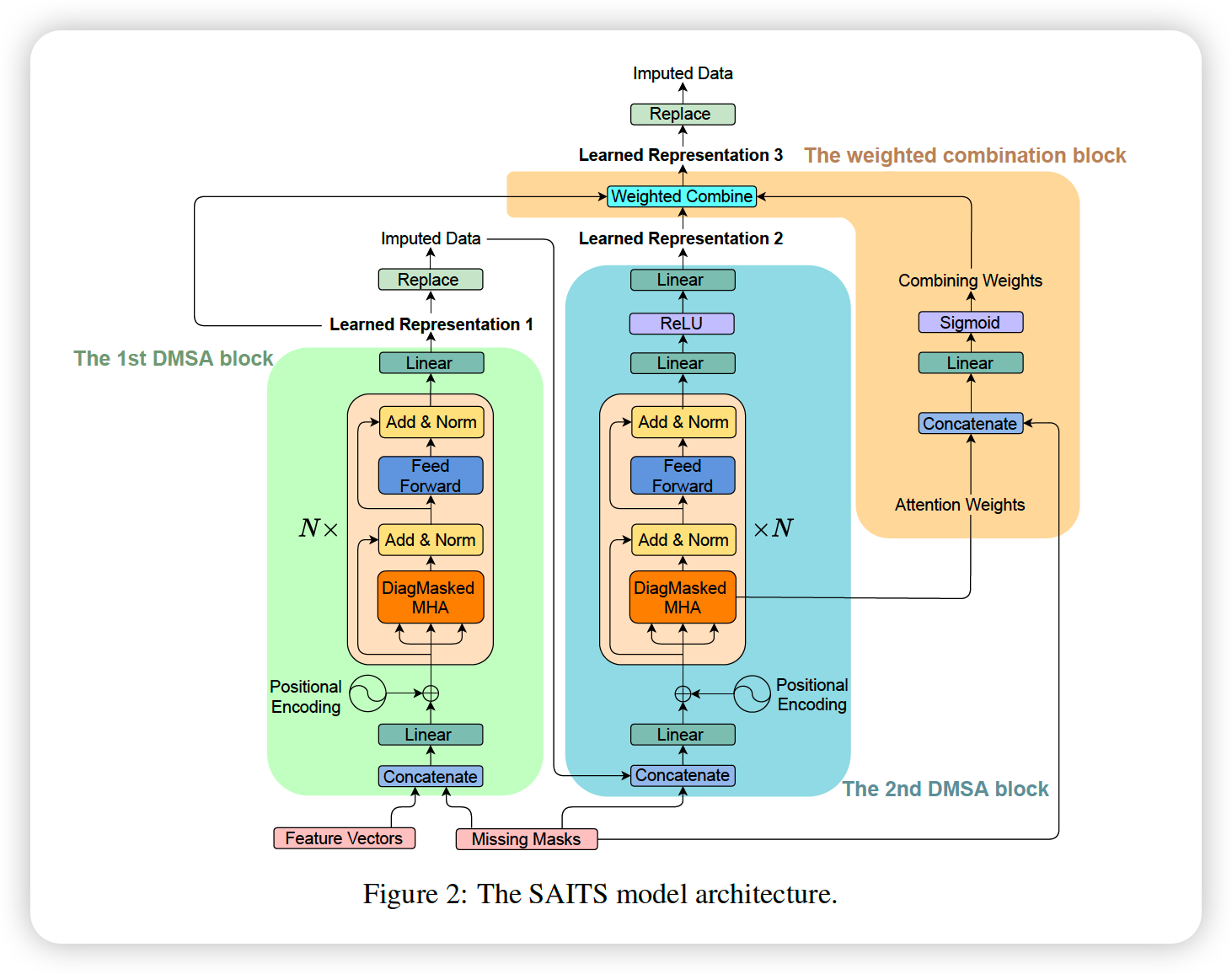SAITS : Self-Attention-based Imputation for TS (2022)
Contents
-
Abstract
- Related Work
- Methodology
- Joint-Optimization Training Approach
- SAITS
- DMSA ( Diagonally Masked Self-Attention )
- Positional Encoding & Feed-forward Network
- First DMSA Block
- Second DMSA Block
- Weighted Combination Block
- Loss Functions
0. Abstract
SAITS
- self-attention
- for missing value imputation
- in MTS
Details
- joint optimization approaches
- learns missing values froma weighted combination of 2 DMSA blocks
- DMSA = Diagonally-Masked Self-Attention block
- captures both …
- “temporal dependencies”
- “feature correlations between time steps”
1. Related Work
4 categories of TS imputation
(1) RNN-based
GRU-D
- GRU variant
- time decay on the last observation
M-RNN & BRITS
- impute missing values according to hidden states from bi-RNN
- difference
- M-RNN : treats missing values as constants
- BRITS : takes correlations among features
(2) GAN-based
- also RNN-based ( + GAN framework )
-
G & Dare both based on GRUI
- since it is RNN-based…
- time-consuming & memory constraints & long-term dependency problem
(3) VAE-based
- GAN & VAE-based : difficult to train
(4) Self-attention based
CDSA
- cross-dimensional self-attention, from 3 dimensions
- time / location / measurement
- impute missing values in geo-tagged data
- (problem) specifically designfed for spatiotemporal data
DeepMVI
-
missing value imputation in multidimensional TS data
-
(problem) not open-source
NRTIS
- TS imputation approach treating time series as a set of (time, data) tuples
- (problem) consists of 2 nested loops …..
2. Methodology
made up of 2 parts
- (1) joint-optimization of “imputation & reconstruction”
- (2) SAITS model ( =weighted combination of 2 DMSA blocks )
(1) Joint-Optimization Training Approach
Notation
- MTS : \(X=\left\{x_{1}, x_{2}, \ldots, x_{t}, \ldots, x_{T}\right\} \in \mathbb{R}^{T \times D}\).
- \(t\)-th observation : \(x_{t}=\left\{x_{t}^{1}, x_{t}^{2}, \ldots, x_{t}^{d}, \ldots, x_{t}^{D}\right\}\)
- Missing mask vector : \(M \in \mathbb{R}^{T \times D}\)
- \(M_{t}^{d}= \begin{cases}1 & \text { if } X_{t}^{d} \text { is observed } \\ 0 & \text { if } X_{t}^{d} \text { is missing }\end{cases}\).
2 learning tasks
- (1) MIT ( = Masked Imputation Task )
- (2) ORT ( = Observed Reconstruction Task )
\(\rightarrow\) two loss functions are added
Task 1 : MIT
Details :
- ARTIFICIALLY masked value ( predict this missing values )
- mask at random
- calculate imputation loss ( use MAE )
Notation
- \(\hat{X}\) : actual input feature vector
- \(\hat{M}\) : corresponding missing mask vector
- REAL vs FAKE missing : \(I\)
Mask vectors
\(\hat{M}_{t}^{d}=\left\{\begin{array}{ll} 1 & \text { if } \hat{X}_{t}^{d} \text { is observed } \\ 0 & \text { if } \hat{X}_{t}^{d} \text { is missing } \end{array}, \quad I_{t}^{d}= \begin{cases}1 & \text { if } \hat{X}_{t}^{d} \text { is artificially masked } \\ 0 & \text { otherwise }\end{cases}\right.\).
MLM vs MIT
- inspired by MLM
- difference
- MLM : predicts missing tokens ( time steps )
- MIT : predict missing values in time steps
- disadvantages of MLM : “discrepancy”
- masking symbols used during pretraining are absent from real data in fine tuning
- no such discrepancy in MIT!
Task 2 : ORT
- reconstruction task ( on the observed values )
- use MAE
Sumamry
- MIT : force the model to predict missing values as accurately as possible
- ORT : ensure that the model converge to the distn of observed data
(2) SAITS
composed of 2 DMSA blocks & weighted combination

a) DMSA ( Diagonally Masked Self-Attention )
( before )
- \[\text { SelfAttention }(Q, K, V)=\operatorname{Softmax}\left(\frac{Q K^{\top}}{\sqrt{d_{k}}}\right) V\]
( diagonal mask )
- \([\operatorname{DiagMask}(x)](i, j)= \begin{cases}-\infty & i=j \\ x(i, j) & i \neq j\end{cases}\).
( after )
- \(\operatorname{DiagMaskedSelfAttention}(Q, K, V) =\operatorname{Softmax}\left(\operatorname{DiagMask}\left(\frac{Q K^{\top}}{\sqrt{d_{k}}}\right)\right) V =A V\).
cannot see themselves
\(\rightarrow\) only on the input values from other \((T-1)\) time steps
\(\rightarrow\) able to capture temporal dependencies & feature correlations
b) Positional Encoding & Feed-forward Network
- skip
c) First DMSA Block
- skip
d) Second DMSA Block
- skip
e) Weighted Combination Block
\(\begin{gathered} \hat{A}=\frac{1}{h} \sum_{i}^{h} A_{i} \\ \eta=\operatorname{Sigmoid}\left(\operatorname{Concat}(\hat{A}, \hat{M}) W_{\eta}+b_{\eta}\right) \\ \tilde{X}_{3}=(1-\eta) \odot \tilde{X}_{1}+\eta \odot \tilde{X}_{2} \\ \hat{X}_{c}=\hat{M} \odot \hat{X}+(1-\hat{M}) \odot \tilde{X}_{3} \end{gathered}\).
- dynamically weiht \(\tilde{X_1}\) & \(\tilde{X_2}\)
f) Loss Functions
\(\begin{aligned} \ell_{\mathrm{MAE}}(\text { estimation, target, mask }) &=\frac{\sum_{d}^{D} \sum_{t}^{T} \mid(\text { estimation }-\text { target }) \odot \text { mask }\left. \mid _{t} ^{d}}{\sum_{d}^{D} \sum_{t}^{T} \text { mask }_{t}^{d}} \\ \mathcal{L}_{\mathrm{ORT}}=\frac{1}{3}\left(\ell_{\mathrm{MAE}}\left(\tilde{X}_{1}, \hat{X}, \hat{M}\right)\right.&\left.+\ell_{\mathrm{MAE}}\left(\tilde{X}_{2}, \hat{X}, \hat{M}\right)+\ell_{\mathrm{MAE}}\left(\tilde{X}_{3}, \hat{X}, \hat{M}\right)\right) \\ \mathcal{L}_{\mathrm{MIT}} &=\ell_{\mathrm{MAE}}\left(\hat{X}_{c}, X, I\right) \\ \mathcal{L} &=\mathcal{L}_{\mathrm{ORT}}+\mathcal{L}_{\mathrm{MIT}} \end{aligned}\).
